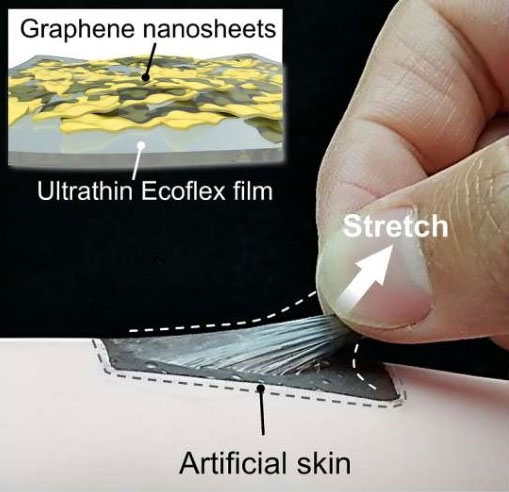Invention of biomimetic skin senses pain
This tool has a function to support enhanced tension perception (SPS). From there, it helps to realize the transition from feeling to feeling pain. The study was published in the journal Advanced Function Materials.

The bio-skin type includes elastic thin films and graphene nanosheets.
Organisms with biological soft tissues (e.g. skin) can achieve self-protection through passive mechanical tension and active perception of external stimuli.
Before mechanical stress, the active protective layer can sense danger. This greatly reduces the risk of injury. However, there are still many challenges to achieving effective active protection.
To solve this problem, researchers at NIMTE have prepared a new type of biomimetic skin. This is an elastic and conductive membrane (ECF). This skin is composed of elastic thin films and graphene nanosheets.
They are assembled with an interlocking structural interface. SPS effect for soft skin with dynamic transition, from touch to pain.
The two-dimensional (2D) graphene-based ECF exhibits a positive correlation between the measure coefficient and the strain, similar to the sensory system of an organism. In addition, synthetic biomimetic skin can achieve normal tactile perception under low tension conditions and pain perception above the stress threshold.
In addition, the strain sensing threshold value can be adjusted from ~7.2% to ~95.3%. That shows, great potential in developing diverse applications related to SPS.
The SPS-assisted sensory system can effectively simulate the pain sensation of human tissues in such cases as one-way overextension of muscle tendons and unequal extensor deformation of hand skin.
Inspired by the puffer fish, scientists at NIMTE designed an ECF-based biomodel as a self-supporting artificial skin. As a result, non-contact and contact mechanical stimuli are detected. At the same time, it actively inflates itself into a 3D form.
Excessive 3D distortion can be effectively captured thanks to the typical SPS effect. The new technology shows promise in the areas of human-machine interaction, intelligent prosthetics and robotics, scientists say.
- Video: The senses sometimes deceive yourself
- Warning signs of skin cancer that you cannot see with the naked eye
- New invention: Measuring blood sugar without pain
- Ion nozzles help kill bacteria effectively
- Electronic skin helps people with limbs feel pain and objects
- Computer equipment mimics the human senses
- 5 senses 'unmask' limits the peak of humans
- Nano patches help relieve muscle pain
- Why is it weak or hurt?
- Unusual pain helps you diagnose yourself
- Why does rain make pain worse?
- The mouse senses oxygen by skin
 Daily use inventions come from universities
Daily use inventions come from universities Special weight loss device helps prevent appetite
Special weight loss device helps prevent appetite 8 inventors were killed by their own inventions
8 inventors were killed by their own inventions Iran invented a motor car powered by water
Iran invented a motor car powered by water